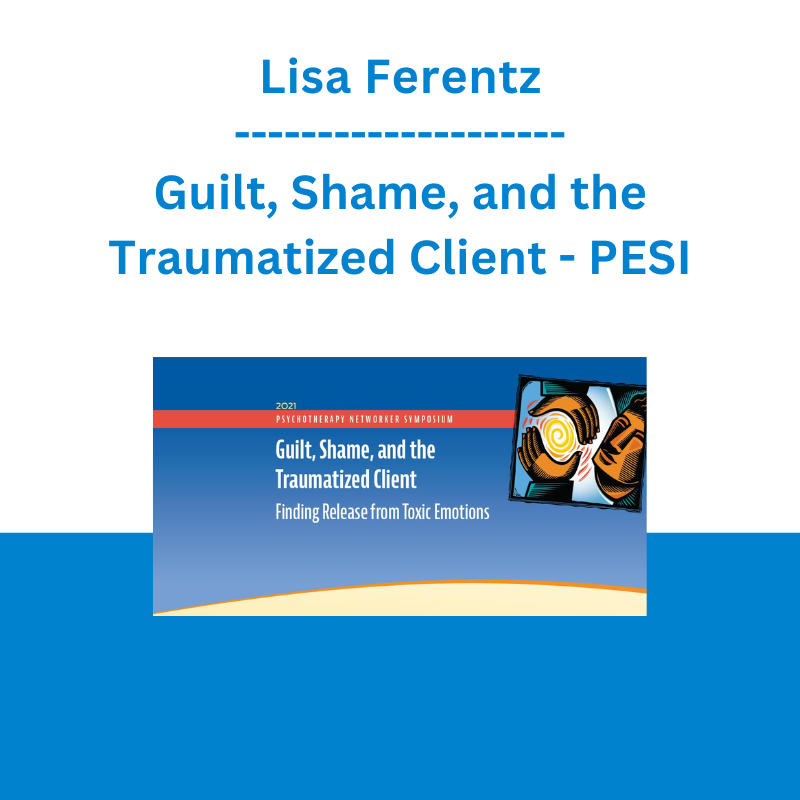*** Proof of Product ***
Exploring the Essential Features of “Lisa Ferentz – Guilt, Shame, and the Traumatized Client: Finding Release from Toxic Emotions – PESI”
Speaker: Lisa Ferentz, LCSW-C, DAPA
Media Type: Digital Seminar
Description
Although trauma can affect clients’ inner lives in countless ways, most survivors grapple with deep-seated feelings of guilt and shame. Until these powerful and debilitating emotions are specifically addressed, it’s difficult for clients to fully heal. In this recording, learn how to compassionately help clients understand the root causes of shame and guilt, and offer creative strategies for releasing themselves from the grip of these toxic emotions. You’ll explore:
- The difference between guilt and shame, and why shame is so difficult to resolve
- The specific dynamics of trauma and early childhood coping strategies that promote and sustain shame
- How secondary gain and “protective parts” affect clients’ willingness to let go of shame
- How to cognitively, somatically, and creatively enhance the two antidotes to shame: self-compassion and curiosity
Speaker
Lisa Ferentz, LCSW-C, DAPA, is a recognized expert in the strengths-based, de-pathologized treatment of trauma and has been in private practice for over 35 years. She presents workshops and keynote addresses nationally and internationally, and is a clinical consultant to practitioners and mental health agencies in the United States, Canada, the UK and Ireland.
She has been an adjunct faculty member at several Universities, and is the Founder of “The Ferentz Institute,” now in its 11th year of providing continuing education to mental health professionals and graduating over 1,200 clinicians from her two certificate programs in Advanced Trauma Treatment.
In 2009, she was voted the “Social Worker of Year” by the Maryland Society for Clinical Social Work. Lisa is the author of Treating Self-Destructive Behaviors in Trauma Survivors: A Clinician’s Guide, 2nd Edition (Routledge, 2014), Letting Go of Self-Destructive Behaviors: A Workbook of Hope and Healing (Routledge, 2014), and Finding Your Ruby Slippers: Transformative Life Lessons From the Therapist’s Couch (PESI, 2017). Lisa also hosted a weekly radio talk show, writes blogs and articles for websites on self-harm and self-care.
Speaker Disclosures:
Financial: Lisa Ferentz maintains a private practice and is the Founder and President of the Ferentz Institute. She receives royalties as a published author and is a consultant for Northwest Hospital. Lisa Ferentz receives a speaking honorarium and product royalties from Psychotherapy Networker and PESI, Inc. She has no relevant financial relationships with ineligible organizations.
Non-financial: Lisa Ferentz is a member of the National Association of Social Workers and the American Psychotherapy Association.
Objectives
- Determine the difference between guilt and shame for clients, and why shame is so difficult to resolve.
- Determine the specific dynamics of trauma and early childhood coping strategies that promote and sustain shame.
- Evaluate how secondary gain and “protective parts” impact clients’ willingness to let go of shame.
- Assess the role the therapeutic relationship plays in helping clients process shame.
- Determine how to cognitively, somatically, and creatively enhance clients’ self-compassion and curiosity to help them let go of shame.
Outline
Explain the difference between guilt and shame for clients, and why shame is so difficult to resolve.
- Guilt as a byproduct of an interpersonal exchange or a behavioral choice versus core feelings of worthlessness or being inherently damaged or “bad.”
- Apologizing and making amends versus fundamentally changing one’s sense of self
Determine the specific dynamics of trauma and early childhood coping strategies that promote and sustain shame.
- Witnessing abuse, survivor guilt, the shame of keeping silent, the shame of “participating” in sexual trauma, misunderstanding the freeze response
- Taking ownership of trauma to preserve familial loyalty
Explore how secondary gain and “protective parts” impact clients’ willingness to let go of shame.
- Reducing expectations, the risk of failing or disappointing others
- Rationalizing self-destructive and addictive behaviors
- Inner critics using shame to “motivate” and prevent abandonment
Consider the role the therapeutic relationship plays in helping clients process shame.
- Modeling self-compassion and positive self-talk
- Using psychoeducation and curiosity to release clients from self-blame
- The healing impact of attunement
Describe how to cognitively, somatically, and creatively enhance clients’ self-compassion and curiosity to help them let go of shame.
- Using the “crossroad of a thought” and “double standard” cognitive strategies to let go of shame
- Using “remembered resource,” sand tray work, art strategies, two-handed writing, and spirituality to creatively enhance compassion
- Using “focusing,” body map, and somatic resourcing to understand the somatic impact of shame and bring comfort to the debilitating emotion
Target Audience
- Counselors
- Social Workers
- Psychologists
- Psychotherapists
- Therapists
- Marriage & Family Therapists
- Addiction Counselors
- Case Managers
- Physicians
- Nurses
- Other Mental Health Professionals
Please see the full list of alternative group-buy courses available here: https://lunacourse.com/shop/









